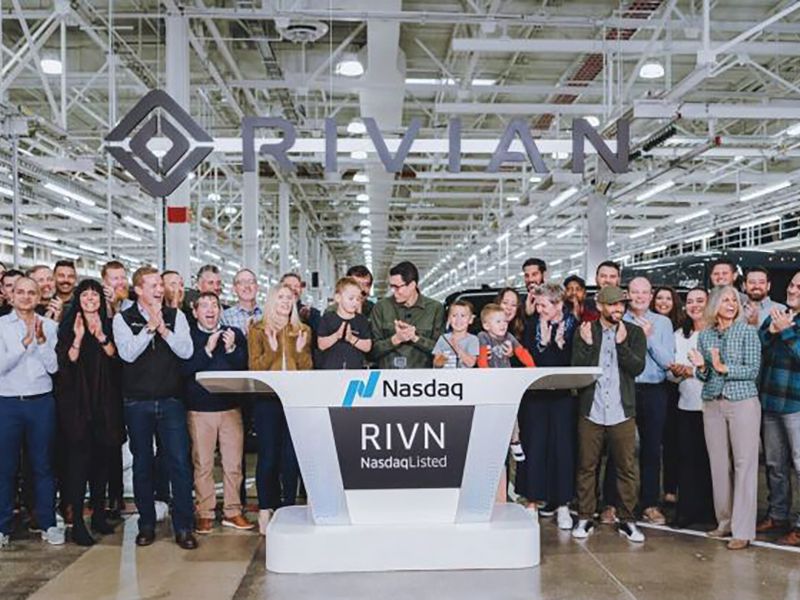
Rivian’s initial public offering on Wednesday infused its ledger with nearly $12 billion, boosting the electric truck startup’s cash cushion to roughly $16 billion.
After rising 29 percent in its first day of trading on the Nasdaq exchange, its shares closed at $100.73, giving it a market cap $88.2 billion. By comparison, General Motors’ was $85.1 billion, Toyota Motor Corp.’s was $289.36 billion and Tesla Inc.’s was $1.07 trillion.
So, founder and CEO RJ Scaringe, can quit worrying about money, right?
Wrong.
Despite the windfall from Wall Street, Rivian is a long, long way from easy street.
Half of that $16 billion has already been allocated. In the first half of this year alone, Rivian recorded a net loss of nearly $1 billion. And profits from vehicle sales will not come quick, the company says.
The cash demands on the company in the next three years as it ramps up production, invests in new models, opens service centers, adds headcount, expands overseas, builds a new factory, etc., could very well see Rivian, like Tesla, make return trips to the capital markets to recharge its finances.
“We anticipate our cumulative spending on capital expenditures to be approximately $8 billion through the end of 2023 to support our continued commercialization and growth objectives as we strategically invest in infrastructure, including additional manufacturing capacity, battery cell production, service operations, charging networks, experience spaces, and software development,” Rivian told investors.
While Rivian has started delivering the first R1T pickups to retail customers and has pivoted to being a revenue-generating company, expenditures in the coming years will likely far surpass revenue.
In fact, according to Rivian’s stock prospectus, the first vehicles are being sold at a loss, something Laura Schwab, recently departed vice president of sales and marketing, raised concerns about.
And even if Rivian sells at full price every R1T, R1S SUV and electric delivery van it can build, the company still won’t make money.
According to Rivian: “We expect to operate at a negative gross profit per vehicle for the near term as our fixed costs from investments in vehicle technology, manufacturing capacity and charging infrastructure are spread across a smaller product base until we launch additional vehicles and ramp production. This dynamic will cause our gross profit losses to increase on a dollar basis even as our revenue increases from ramping production volumes over the short to medium term.”
Here, according to Rivian, are some of the biggest expenditures it’s facing through 2025:
- New factory: Rivian’s plant in Normal, Ill., has a capacity of 150,000 vehicles, not enough to enable profitable high-volume production of the company’s first three models. Over the summer, Rivian disclosed it is scouting locations for a second plant, referred to internally as Project Tera. As envisioned, that plant will also include battery pack production. It would require at least 2,000 acres, and company plans call for it to be opened sometime in 2023. Price tag: $5 billion.
- Expanded lineup: Rivian trademarked the names R3S, R4S, R5S, R3T, R4T and R5T for what are believed to be smaller electric pickups and SUVs, some tailored specifically for overseas markets, such as China and Europe. The new vehicles will require a different platform from that currently used for the R1T and R1S. Consulting firm McKinsey & Co. estimates it costs automakers at least $1 billion for each new EV architecture.
- Service centers: This year, Rivian began opening service centers in what it believes will be its biggest markets, 120 in all. Additionally, the company is building a fleet of 1,000 service vans for company technicians to bring service to the customer. Cost: unknown.
- Rivian Adventure Network: The company is building a dedicated DC fast-charging network, some 600 locations with a total of 3,500 chargers, for exclusive use by Rivian customers. The company also is planning to build a network of 10,000 Level 2 chargers across the U.S. and Canada. No estimated cost from Rivian is available. But the charging network will be a major expenditure. According to one source, a two-plug commercial Level 2 charger costs about $7,200. And, according to the California Energy Commission, one DC fast charger with four plugs costs an average of $103,027. Using that math, the Adventure Network and the Level 2 chargers could cost Rivian around $430 million.
- Legal costs: As of Sept. 30, Rivian could sell its vehicles in only 22 states. Rivian is fighting efforts that prevent sales in the other 28 states, a likely long and protracted legal battle. The company’s strategy is outlined in its stock prospectus: “We intend to actively fight any such efforts to limit our ability to operate, as well as proactively undertake efforts to open states currently closed to our business model. In fact, in 2020 we succeeded in a two-year long effort to open up the state of Colorado to direct sales and service by manufacturers that produce only EVs and have not entered into the franchise dealer system. In 2021, we similarly succeeded in a legislative effort to confirm the permissibility of our sales and service model in the state of Vermont in a bill that was signed into law earlier this year. In 2021, we also successfully fended off attacks in the states of Florida, Idaho and Oklahoma to limit or restrict our ability to conduct sales or service.” Cost: unknown.

